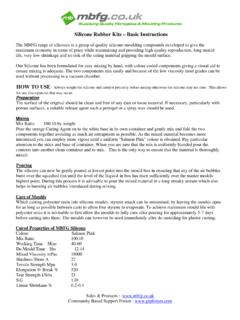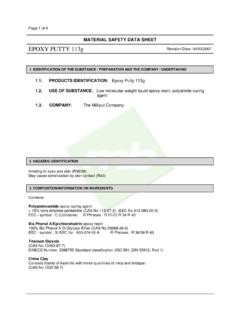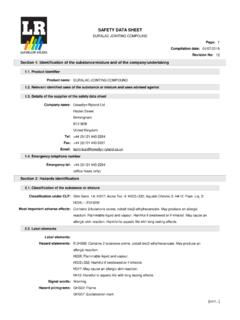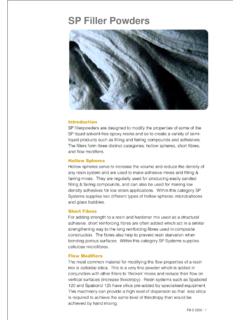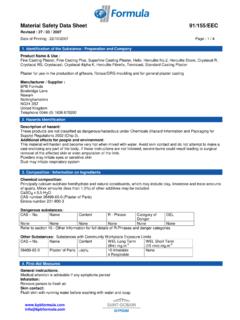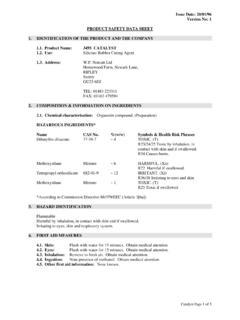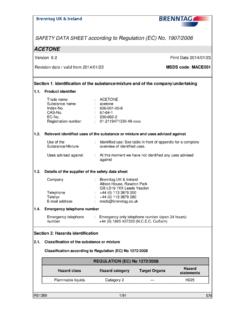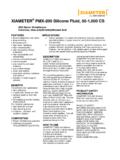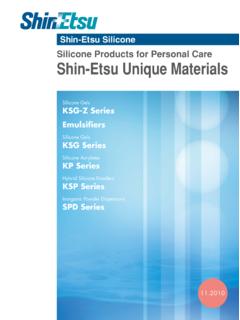Transcription of RTC-10F CURING AGENT - mbfgfiles.co.uk
1 Page 1 of 20 SAFETY DATA SHEET Safety Data Sheet according to Reg. (EU) No 2015/830 Product name: POLYCRAFT RTC-10F /VF CURING AGENT Print Date: SECTION 1: IDENTIFICATION OF THE SUBSTANCE/MIXTURE AND OF THE COMPANY/UNDERTAKING Product identifier Product name: POLYCRAFT RTC-10F /VF CURING Relevant identified uses of the substance or mixture and uses advised against Identified uses: Vulcanising agents Polymer Details of t he supplier of the safety data sheet COMPANY IDENTIFICATION MB Fibreglass Unit 17 & 20 Abbey Business ParkMill RoadNewtownabbeyBT36 7 EECustomer Information Number: Tel: 02890 861992 Email: EMERGENCY TELEPHONE NUMBER Local Emergency Contact: 02890 861992 SECTION 2: HAZARDS IDENTIFICATION Classification of the substance or mixture Classification according to Regulation (EC) No 1272/2008.
2 Reproductive toxicity - Category 2 - H361 Specific target organ toxicity - repeated exposure - Category 2 - Oral - H373 For the full text of the H-Statements mentioned in this Section, see Section 16. Page 2 of 20 Label elements Labelling according to Regulation (EC) No 1272/2008: Hazard pictograms Signal word: WARNING Hazard statements H361 Suspected of damaging fertility or the unborn child. H373 May cause damage to organs (Bladder, Kidney, Central nervous system) through prolonged or repeated exposure if swallowed.
3 Precautionary statements P201 Obtain special instructions before use. P202 Do not handle until all safety precautions have been read and understood. P260 Do not breathe dust/ fume/ gas/ mist/ vapours/ spray. P280 Wear protective gloves/ protective clothing/ eye protection/ face protection. P308 + P313 IF exposed or concerned: Get medical advice/ attention. P501 Dispose of contents/ container to an approved waste disposal plant. Contains Trimethoxyphenylsilane; Bis[(2-ethyl-2,5-dimethylhexanoyl)oxy](d imethyl)stannane Other hazards This product contains no substances assessed to be PBT or vPvB at levels of or higher.
4 SECTION 3: COMPOSITION/INFORMATION ON INGREDIENTS Chemical nature: Organotin compound Mixtures This product is a mixture. CASRN / EC-No. / Index-No. REACH Registration Number Concentration Component Classification: REGULATION (EC) No 1272/2008 CASRN 2996-92-1 EC-No. 221-066-9 Index-No. 01-2119964479-19>= - <= % Trimethoxyphenylsilane Flam. Liq. - 3 - H226 Acute Tox. - 4 - H302 STOT RE - 2 - H373 Product name: POLYCRAFT RTC-10F /VF CURING AGENT Print Date: Page 3 of 20 CASRN 68928-76-7 EC-No. 273-028-6 Index-No.
5 01-2120770324-57>= - <= % Bis[(2-ethyl-2,5-dimethylhexanoyl)oxy](dimethyl)stannane Acute Tox. - 4 - H302 Repr. - 2 - H361 STOT RE - 1 - H372 Aquatic Chronic - 3 - H412 CASRN >= - <= % methanol Flam. Liq. - 2 - H225 Acute Tox. - 3 - H301 Acute Tox. - 3 - H331 Acute Tox. - 3 - H311 STOT SE - 1 - H370 CASRN _ <= % Tetramethyl orthosilicate Flam. Liq. - 3 - H226 Acute Tox. - 1 - H330 Skin Irrit. - 2 - H315 Eye Dam. - 1 - H318 STOT RE - 1 - H372 For the full text of the H-Statements mentioned in this Section, see Section 16.
6 SECTION 4: FIRST AID MEASURES Description of first aid measures General advice: First Aid responders should pay attention to self-protection and use the recommended protective clothing (chemical resistant gloves, splash protection). If potential for exposure exists refer to Section 8 for specific personal protective equipment. Inhalation: Move person to fresh air; if effects occur, consult a physician. Skin contact: Wash off with plenty of water. Suitable emergency safety shower facility should be available in work area.
7 Eye contact: Flush eyes thoroughly with water for several minutes. Remove contact lenses after the initial 1-2 minutes and continue flushing for several additional minutes. If effects occur, consult a physician, preferably an ophthalmologist. Suitable emergency eye wash facility should be available in work area. Ingestion: If swallowed, seek medical attention. Do not induce vomiting unless directed to do so by medical personnel. Most important symptoms and effects, both acute and delayed: Aside from the information found under Description of first aid measures (above) and Indication of immediate medical attention and special treatment needed (below), any additional important symptoms and effects are described in Section 11: Toxicology Information.
8 Indication of any immediate medical attention and special treatment needed Notes to physician: No specific antidote. Treatment of exposure should be directed at the control of symptoms and the clinical condition of the patient. Product name: POLYCRAFT RTC-10F /VF CURING AGENT Print Date: Page 4 of 20 SECTION 5: FIREFIGHTING MEASURES 5. 1 Extinguishing media Suitable extinguishing media: Water spray. Alcohol-resistant foam. Carbon dioxide (CO2). Dry chemical. Unsuitable extinguishing media: High volume water jet.
9 Do not use direct water 5. 2 Special hazards arising from the substance or mixture Hazardous combustion products: Carbon oxides. Silicon oxides. Formaldehyde. Metal oxides. Nitrogen oxides (NOx). Unusual Fire and Explosion Hazards: Flash back possible over considerable Exposure to combustion products may be a hazard to Vapours may form explosive mixtures with 5. 3 Advice for firefighters Fire Fighting Procedures: Fire residues and contaminated fire extinguishing water must be disposed of in accordance with local Use water spray to cool fire exposed containers and fire affected zone until fire is out and danger of reignition has Do not use a solid water stream as it may scatter and spread Use extinguishing measures that are appropriate to local circumstances and the surrounding environment.
10 Use water spray to cool unopened containers. Collect contaminated fire extinguishing water separately. This must not be discharged into drains. Remove undamaged containers from fire area if it is safe to do so. Evacuate area. Special protective equipment for firefighters: In the event of fire, wear self-contained breathing Use personal protective SECTION 6: ACCIDENTAL RELEASE MEASURES Personal precautions, protective equipment and emergency procedures: Remove all sources of ignition. Use personal protective equipment.
